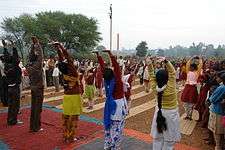Surya Namaskara


Surya Namaskara (Sanskrit: सूर्यनमस्कार, IPA: [suːrjɐ nəməskɐːrɐ]; IAST: Sūrya Namaskāra), or Sun Salutation, is a Yoga warm up routine based on a sequence of gracefully linked asanas.[2][3] The nomenclature refers to the symbolism of Sun as the soul and the source of all life.[4] It is relatively a modern practice that developed in the 20th century.[5]
Sūrya Namaskāra may also refer to other styles of "Sun Salutations". A yogi may develop a personalized yoga warm up routine as surya-namaskar to precede his or her asana practice.[6]
History
Mysore
Some scholars attribute modern Surya namaskar practice to Tirumalai Krishnamacharya teachings. It includes modern day Ashtanga Vinyasa Yoga and the Visesha Vinyasa Sun Salutation subroutine from Vinyasa Krama Yoga,[7] as well as a host of other popular forms of yoga.[8]
Raja of Aundh
In his work The Yoga Body, Mark Singleton states Sūryanamaskāra may have been invented by Patinidhi Pant, the Rajah of Aundh.[9] He adds that there is no evidence that the Sūryanamaskāra sequence was practiced prior to the early 20th century.[10] According to Alter, while Pant Pratinidhi of Aundh called the warm up routine as surya namaskar,[11] how exactly Sūrya Namaskāra came to be included in the yogic practices of Hatha and Ashtanga Yoga in India remains unclear.[12]
His Holiness Meherban Shrimant Raja BHAVAN RAO SHRINIVAS 'BALA SAHIB', Pant Pratinidhi of Aundh (1868–1951; Raja of Aundh 1909-1947)[13] occupies an important position in the history of surya namaskar. He helped to popularize surya namaskar as a simple physical exercise, introducing it into schools and encouraged ordinary men to be physically fit by performing surya namaskar every day.[14] Some Western scholars classify surya namaskar as a modern physical exercise invented by Raja of Aundh.[15][16] The Raja of Aundh himself never claimed to have invented Surya Namaskar, but rather stressed an ancient origin for this procedure.[14]
Other references
Early English publications record some ancient methods of sun salutation; however, they do not seem to be related to the modern Sūrya Namaskāra as seen in Yoga practice today. It is widely believed in the state of Maharashtra that Shivaji Maharaj, Sage Samarth Ramdas and the Marathas have performed Sūrya Namaskāra as a physical exercise to develop able bodies.[17]

Aditya Hridayam[18][19][20] is another ancient practice which involves a verbal variation of Sūrya Namaskāra. It is a procedure of saluting The Sun, taught to Rama by Sage Agastya, before his fight with Ravana. It is described in the "Yuddha Kaanda" Canto 107 of Ramayana.
Practice
Any warm-up routine prior to a dedicated asana practice can constitute a Surya Namaskar.[6] The following lists one warm up routine for Surya Namasakar.[3] Other variations such as Surya Namasakar exist.[3]
| Step | Asana | Breath | Images | Chakra | Position | Bīja | |
|---|---|---|---|---|---|---|---|
| Sanskrit | Transliteration | ||||||
| 1 | Pranamasana | exhale | |
Anahata | Heart | ॐ ह्रां | om hrāṁ |
| 2 | Hasta Uttanasana | inhale | |
Vishuddhi | Throat | ॐ ह्रीं | om hrīṁ |
| 3 | Hastapaadasana | exhale | |
Swadhisthana | Sacrum | ॐ ह्रूं | om hrūṁ |
| 4 | Aekpaadprasarnaasana (one foot back, lift head, hands often on earth ) | inhale | |
Ajna | Third eye | ॐ ह्रैं | om hraiṁ |
| 5 | Adho Mukha Svanasana / parvatasana | exhale | |
Vishuddhi | Throat | ॐ ह्रौं | om hrauṁ |
| 6 | Ashtanga Namaskara | suspend | |
Manipura | Solar plexus | ॐ ह्रः | om hraḥ |
| 7 | Bhujangasana | inhale | |
Swadhisthana | Sacrum | ॐ ह्रां | om hrāṁ |
| 8 | Adho Mukha Svanasana | exhale | |
Vishuddhi | Throat | ॐ ह्रीं | om hrīṁ |
| 9 | Ashwa Sanchalanasana (opposite foot forward from 4, hands often on earth ) | inhale | |
Ajna | Third eye | ॐ ह्रूं | om hrūṁ |
| 10 | Uttanasana | exhale | |
Swadhisthana | Sacrum | ॐ ह्रैं | om hraiṁ |
| 11 | Hasta Uttanasana | inhale | |
Vishuddhi | Throat | ॐ ह्रौं | om hrauṁ |
| 12 | Pranamasana | exhale | |
Anahata | Heart | ॐ ह्रः | om hraḥ |
Routine
12 Surya Namaskaras are practised per cycle.
See also
| Wikimedia Commons has media related to Surya Namaskar. |
References
- ↑ Indian Express (4 September 2010). Destination Delhi.
- ↑ Carol Mitchell (2003). Yoga on the Ball. Inner Traditions. p. 48. ISBN 978-0-89281-999-7.
- 1 2 3 Jane MacMullen (1988). Yoga Journal: Ashtanga Yoga. September/October. Active Interest. pp. 68–70.
- ↑ Krishan Kumar Suman (2006). Yoga for Health and Relaxation. Lotus. pp. 83–84. ISBN 978-81-8382-049-3.
- ↑ Mark Singleton (2010). Yoga Body: The Origins of Modern Posture Practice. Oxford University Press. pp. 180–181, 205–206. ISBN 978-0-19-974598-2.
- 1 2 Donna Schuster (1990). Yoga Journal. October-November. Active Interest. p. 57.
- ↑ Ramaswami 2005, p. 213-219.
- ↑ Singleton 2010, p. 176.
- ↑ Mark Singleton (2010), Yoga Body: The Origins of Modern Posture Practice, Oxford University Press, ISBN 978-0-19-539534-1, page 124
- ↑ Mark Singleton (2010), Yoga Body: The Origins of Modern Posture Practice, Oxford University Press, ISBN 978-0-19-539534-1, pages 180-181, 205-206
- ↑ Alter 2000, p. 99.
- ↑ Alter 2004, p. 23.
- ↑ S.P.Sen, Dictionary of National Biography; Institute of Historical Studies, Calcutta 1972 Vols.1-4; Institute of Historical Studies, vol 3, p.307
- 1 2 Royal India: A Descriptive and Historical Study of India's Fifteen Principal States and Their Rulers By Katherine H. Diver, Maud Diver, (year 1942)
- ↑ Joseph S. Alter, Yoga in Modern India: the body between science and philosophy, Princeton University Press (year 2004)
- ↑ Joseph S. Alter, Gandhi's Body: Sex, Diet, and the Politics of Nationalism, (year 2000)
- ↑ (Editor) Mujumdar 1950.
- ↑ Master Murugan, Chillayah (20 October 2012). "Surya Namaskara -Puranic origins of Valmiki Ramayana". Silambam. Retrieved 31 May 2013.
- ↑ sanskrit.safire.com, Aditya Hrudayam with English translation
- ↑ Translation of Ramayana by Griffith
Sources
- Sjoman, N.E. (1999). Yoga tradition in Mysore Palace. Abhinav publications. ISBN 81-7017-389-2.
- Ramaswami, Srivatsa (2005), The Complete Book of Vinyasa Yoga, Da Capo Press, ISBN 978-1-56924-402-9
- (Editor) Mujumdar, Dattatraya Chintaman (1950), Encyclopedia of Indian Physical Culture: A Comprehensive Survey of the Physical Education in India, Profusely Illustrating Various Activities of Physical Culture, Games, Exercises, Etc., as Handed Over to Us from Our Fore-fathers and Practised in India, Good Companions
- Singleton, Mark (2010), Yoga Body: The Origins of Modern Posture Practice, Oxford University Press
- Alter, Joseph S. (2000), Gandhi's Body: Sex, Diet, and the Politics of Nationalism, University of Pennsylvania Press, ISBN 978-0-812-23556-2
- Alter, Joseph S. (2004), Yoga in Modern India: The Body between Science and Philosophy, Princeton University Press, ISBN 978-0-691-11874-1
- Medin, R. Alexander; Summerbell, Deirdre (2004). "3 Gurus, 48 Questions: Matching interviews with SRI T.K.V. DESIKACHAR, SRI B.K.S. IYENGAR & SRI K. PATTABHI JOIS" (PDF).
External links
- Step-by-step instructions with video by The Art of Living
- Dep't of Posts, Gov't of India releases stamps on Surya Namaskara on International Yoga Day 2016.
